- Home
- Technical Cooperation Projects
- Index of Countries
- Middle East
- Egypt
- The Project for the Conservation Center in the Grand Egyptian Museum
- Project News
- For Inheriting the Colorful Ancient Egyptian Artifacts to the Next Generations – Training Course of Conservation for Painted Objects–
Project News
2013-05-01
For Inheriting the Colorful Ancient Egyptian Artifacts to the Next Generations
– Training Course of Conservation for Painted Objects–
February 25 to March 7, 2013
The favorable Egyptian environmental conditions have resulted to preserve the ancient Egyptian artifacts in good condition. After their discoveries through the archaeological excavations, those artifacts, which are obviously considered as the longing objects of the world, have been inherited to us today. Some of them still retaining the very vivid colors often catch people's much attention and interest. Their support mediums are varying and ranging from the organic materials such as the textile and the cartonnage to the inorganic materials such as the wall painting and the stelai. Taking account of these facts, it could be said that the ancient Egyptians were very skillful to color the varying support mediums of the artifacts. The sources of the colors are of-course the dye and pigments applied on the support mediums.
At the Grand Egyptian Museum Conservation Center (GEM-CC), Japan International Cooperation Agency (JICA) conducted the training course on conservation of the painted artifacts from 22nd of February till 9th of March, 2013 by inviting 3 experts in this field from Japan as they are listed below. The painted artifacts mean the archaeological artifacts made of any kinds of the support mediums, on which the pigments are applied. For conservation work of those painted objects, this training course aimed for the trainees to obtain the common knowledge and experiences and learn the practical methods, which allowing them to progress the work systematically.
Dr. Yoko TANIGUCHI: Assistant Professor of the University of Tsukuba
Ms. Akiko NISHISAKA: Invited Researcher of Waseda University
Dr. Akemi SUGIHARA: Visiting Researcher of National Research Institute for Cultural Properties
The artifacts to be stored and exhibited at the Grand Egyptian Museum, which is going to be officially opened in 2015, are to be consisting of the great variety of the painted artifacts. In the ancient Egypt, not only the wall paintings and the mural paintings, but also the papyruses, the wooden artifacts, the stone artifacts and the varying other materials were painted. A painted layer is always composed by 3 elements, a pigment, a foundation layer and a support medium. Whatever the support mediums of the artifacts, a lot of the common characteristics of the ancient Egyptian painted techniques can be observed. Thus, this training course was designed to deal with the painted artifacts as a whole with the cross sectional views over any support mediums.
This training course also focused on offering the opportunity to the GEM-CC trainees to learn and understand both the fundamental principles for conservation of the painted artifacts and importance of teamwork in practicing conservation work. Especially, it focused 3 significant points; (1) to understand the fundamental characteristics of the paint layers, (2) to establish the cross sectional and cooperative system among conservation laboratories and conservation science and (3) to immplement the unified analytical proformas.
The main targeted trainees were 16 GEM-CC conservators. In addition to them for the purpose of establishing the cross-sectional and cooperative working system, 4 scientists specializing the scanning electron microscope (SEM), the light microscope, the fourier transform nfrared spectroscopy (FTIR) and X-ray diffraction (XRD) were incorporated into this training course with those conservators.
In the first part of the training course, a series of the lectures referring to the characteristics of the materials and techniques of the ancient Egyptian painted artifacts were given to trainees. In addition, trainees had informative experience of making the painted replica samples as the experimental materials to be used in the second part of this training course. As for the second part, documentation, material sampling, the preparation of the cross-section and the observational analysis of the prepared painted replica samples by the erector microscopes, FTIR and X-ray were practiced with use of the analytical proformas.
In the practical training, trainees were divided into 4 groups based on their academic backgrounds, and then each group discussed the given different topics and made the reports of them for the group presentations.
The most of trainees have the fundamental knowledge about the materials and techniques used for the ancient Egyptian painted artifacts, but it was first experience for them to practice the practical training, for example by making the painted replica samples for the analytical purposes and they had the precious opportunity of learning the principled skills and techniques of conservation work of the painted artifacts. Naturally, this training course was very popular and effective among trainees, and their expectation to attend the subsequent advanced course, which is to be held in the next year, was already very high during the course. From now on, while the training course shall be continued by the same 3 Japanese instructors, those trainees will try to make the analytical proformas of the GEM-CC's own and continuously research the developing conditions of the enforcedly deteriorated painted replica samples by themselves.
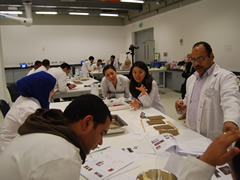 Ms. Nishisaka with GEM-CC Trainees at the Workshop
Ms. Nishisaka with GEM-CC Trainees at the Workshop
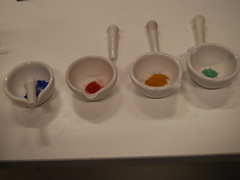 4 Different Colors of Pigments Used for Making the Samples of the Painted Replicas
4 Different Colors of Pigments Used for Making the Samples of the Painted Replicas
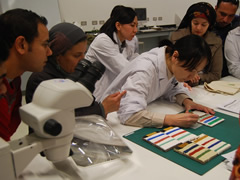 Dr. Taniguchi Explaining the Samples of the Painted Replicas, Which the GEM-CC Trainees Made by Themselves
Dr. Taniguchi Explaining the Samples of the Painted Replicas, Which the GEM-CC Trainees Made by Themselves
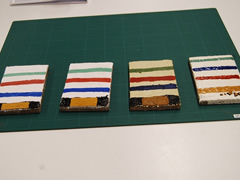 Samples of the Painted Replicas Made by 4 Groups of GEM-CC Trainees
Samples of the Painted Replicas Made by 4 Groups of GEM-CC Trainees
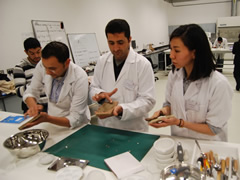 Dr. Sugihara Teaching to the Methods to Make the Samples of the Painted Replicas
Dr. Sugihara Teaching to the Methods to Make the Samples of the Painted Replicas
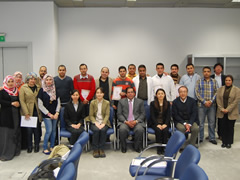 Group Photo after the Successful Training Course
Group Photo after the Successful Training Course
- About JICA
- News & Features
- Countries & Regions
- Our Work
- Thematic Issues
- Types of Assistance
- Partnerships with Other Development Partners
- Climate Change / Environmental and Social Considerations
- Evaluations
- Compliance and Anti-corruption
- Science and Technology Cooperation on Global Issues
- Research
- JICA Development Studies Program / JICA Chair
- Support for the Acceptance of Foreign HRs / Multicultural and Inclusive Community
- Publications
- Investor Relations
